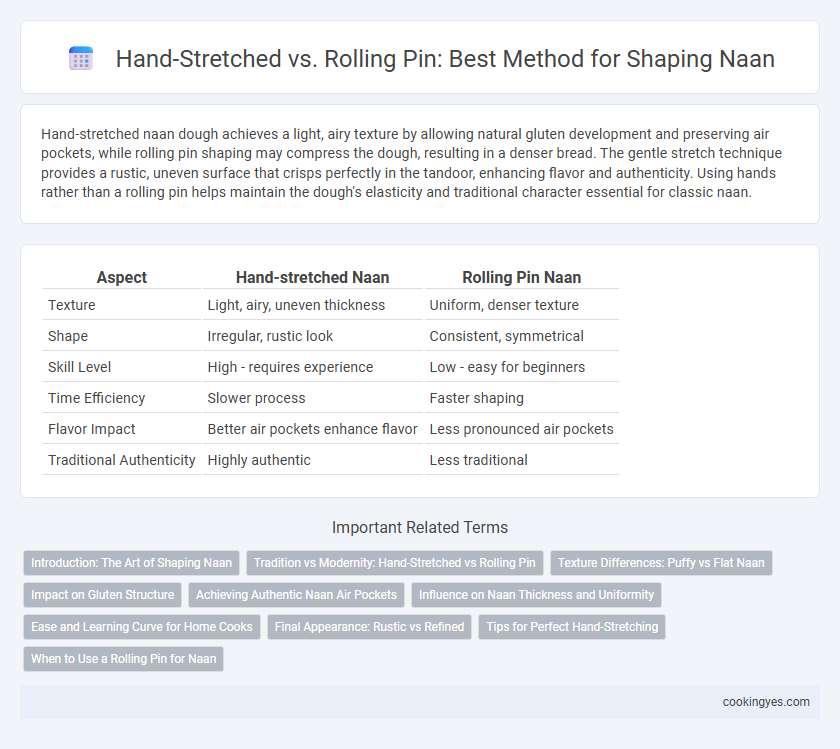Hand-stretched naan dough achieves a light, airy texture by allowing natural gluten development and preserving air pockets, while rolling pin shaping may compress the dough, resulting in a denser bread. The gentle stretch technique provides a rustic, uneven surface that crisps perfectly in the tandoor, enhancing flavor and authenticity. Using hands rather than a rolling pin helps maintain the dough's elasticity and traditional character essential for classic naan.
Table of Comparison
| Aspect | Hand-stretched Naan | Rolling Pin Naan |
|---|---|---|
| Texture | Light, airy, uneven thickness | Uniform, denser texture |
| Shape | Irregular, rustic look | Consistent, symmetrical |
| Skill Level | High - requires experience | Low - easy for beginners |
| Time Efficiency | Slower process | Faster shaping |
| Flavor Impact | Better air pockets enhance flavor | Less pronounced air pockets |
| Traditional Authenticity | Highly authentic | Less traditional |
Introduction: The Art of Shaping Naan
Hand-stretched naan preserves the traditional texture and airy pockets by carefully pulling the dough with fingers, enhancing its softness and chewiness. Using a rolling pin can compact the dough, resulting in a denser bread that lacks the characteristic lightness of authentic naan. Mastering hand-stretching techniques emphasizes the artisanal quality essential for achieving the perfect naan shape and texture.
Tradition vs Modernity: Hand-Stretched vs Rolling Pin
Hand-stretching naan preserves the traditional texture and airiness achieved through gentle, uneven dough manipulation that allows natural gluten elasticity to develop. Using a rolling pin offers efficiency and uniform thickness in modern kitchens but can compress the dough, resulting in denser naan with less characteristic fluffiness. The choice between hand-stretched and rolling pin techniques reflects a balance between authentic culinary heritage and contemporary convenience in naan preparation.
Texture Differences: Puffy vs Flat Naan
Hand-stretched naan develops a puffy, airy texture due to the gentle, uneven pulling that traps air pockets within the dough, resulting in a light and soft crumb. Rolling pin shaping compresses the dough evenly, producing a flatter naan with a denser, chewier texture and fewer bubbles. The choice between hand-stretching and rolling pin directly affects naan's traditional softness and pillowy appearance versus a more uniform, crisp surface.
Impact on Gluten Structure
Hand-stretching naan dough preserves the gluten network by gently elongating the strands, resulting in a light and airy texture with characteristic chewiness. Using a rolling pin compresses and flattens the gluten structure, often breaking the strands and producing a denser, less elastic naan. Maintaining gluten integrity through hand-stretching enhances the naan's softness and ability to puff during baking, key attributes sought in traditional preparation.
Achieving Authentic Naan Air Pockets
Hand-stretching naan dough preserves its natural elasticity, creating uneven tension that forms characteristic air pockets during baking. Using a rolling pin compresses the dough uniformly, which can reduce the formation of these distinctive bubbles essential to authentic naan texture. Mastering hand-stretching techniques enhances the bread's softness and signature puffy crust, replicating traditional tandoor-made naan.
Influence on Naan Thickness and Uniformity
Hand-stretched naan typically results in varying thickness and uneven edges, creating a rustic texture that enhances the bread's airy pockets and chewiness. Using a rolling pin produces a more uniform thickness and consistent shape, which allows for even cooking but may reduce the traditional lightness and texture characteristic of hand-stretched naan. The choice between hand-stretching and rolling directly influences the naan's final texture, thickness profile, and visual appeal.
Ease and Learning Curve for Home Cooks
Hand-stretched naan offers greater control over thickness and texture but requires practice to master the even pulling technique, making it less intuitive for beginners. Using a rolling pin simplifies the shaping process, enabling home cooks to achieve consistent thickness quickly with minimal skill. For ease and faster learning, rolling pins are recommended, while hand-stretching provides authenticity and a more artisanal result once the technique is acquired.
Final Appearance: Rustic vs Refined
Hand-stretched naan yields a rustic, irregular shape with bubbles and charred spots that emphasize its artisanal texture, while rolling pin-shaped naan results in a more uniform, refined appearance with smooth surfaces and even thickness. The uneven tension from hand stretching creates distinctive puffiness and crispy edges, enhancing visual appeal for traditional dining experiences. Rolling pin methods produce consistent thickness, perfect for presentation in fine-dining settings where polished aesthetics are prioritized.
Tips for Perfect Hand-Stretching
Achieving perfect hand-stretched naan requires gentle handling to maintain its airy texture and characteristic bubbles. Use your fingertips to stretch the dough evenly, preserving the gluten structure, and avoid using excessive force that could tear it. Resting the dough adequately before shaping helps improve elasticity, making hand-stretching more effective than using a rolling pin.
When to Use a Rolling Pin for Naan
A rolling pin is ideal for shaping naan when uniform thickness and consistent size are required, especially in larger batches or commercial settings. It ensures even dough flattening, which helps achieve a balanced cooking time and texture. Use a rolling pin when speed and precision are prioritized over the traditional, rustic hand-stretched method.
Hand-stretched vs Rolling pin for Naan shaping Infographic

 cookingyes.com
cookingyes.com